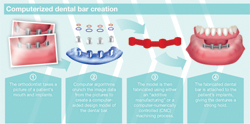Improving dental restoration
Posted by magazine
Oral surgeons may one day have an easier, less costly approach to one important aspect of dental restoration if a newly patented process developed at Missouri S&T takes hold.

(Illustration by Jessica Maglinger)
The process — developed by S&T Professor Ming Leu and Amit Gawate, ME’05 — computerizes the method for creating a dental bar, also called an over-denture. For dental restoration procedures, the device is the bridge connecting dental implants to dentures. Typically, a dental technician creates the device through a laborious manual process that involves molding and casting. But Leu’s approach is entirely digital and automated.
“This method can reduce the cost as well as the time involved” in fabricating dental bars, says Leu, the Keith and Pat Bailey Missouri Distinguished Professor of Integrated Product Manufacturing at Missouri S&T.
The conventional approach involves first making an impression of the area of the mouth where a denture would be placed, then casting a model of the gums and implants. From there, technicians design and fabricate the dental bar from a metal material.
Rather than making a physical model, Leu’s process uses digital imaging technology to take a picture of a patient’s mouth. From there, computer algorithms crunch the image data to create a computer-aided design model of the actual dental bar. That model can then be fabricated using either an “additive manufacturing” or a computer-numerically controlled (CNC) machining process.
“Additive manufacturing is a way of making a part by adding material, one layer at a time, rather than removing material, as you would do with machining,” Leu says. The process uses less material than machining or other processes and can be easily tailored to individualized parts of different geometries, he adds.
An expert in manufacturing, Leu first became interested in dental surgery after a prosthodontist contacted Leu about some previous research with additive manufacturing. In 2000, Leu developed a way to create prototypes of manufactured parts out of ice — a method he called rapid freeze prototyping — and the prosthodontist thought the approach would be a cost-effective way to make models for dental surgery. Together, they obtained funding from the National Science Foundation to investigate the approach. From there, Leu developed the computer-aided method for dental bar design.